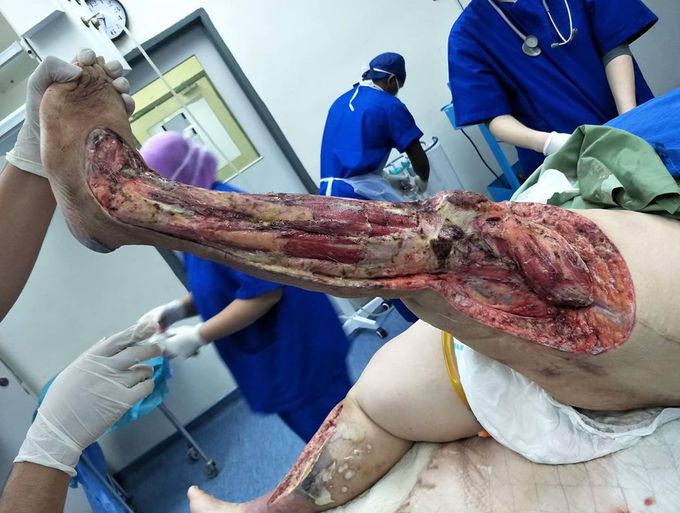


Case of billateral necrotizing fasciitis post debridement surgery showing muscle exposure.
Necrotizing fasciitis is a rapidly progressive inflammatory infection of the fascia, with secondary necrosis of the subcutaneous tissues. Symptoms may include fever, swelling, and complaint of excessive pain. The initial skin changes are similar to cellulitis or abscess, thus making the diagnosis at early stages difficult. The redness and swelling usually blend into surrounding normal tissues. The overlying skin may appear shiny and tense. Other signs which are more suggestive of necrotizing changes (but present in later stages) are: formation of bullae, bleeding into the skin which is present before skin necrosis (skin turning from red to purple and black due to thrombosis of blood vessels), presence of gas in tissues, and reduced or absent sensation over the skin (due to the necrosis of the underlying nerves). Early diagnosis is difficult, as the disease often looks early on like a simple superficial skin infection. While a number of laboratory and imaging modalities can raise the suspicion for necrotizing fasciitis, none can rule it out. The gold standard for diagnosis is a surgical exploration in a setting of high suspicion. Surgical debridement (cutting away affected tissue) is the mainstay of treatment for necrotizing fasciitis. Aggressive wound debridement should be performed early, usually as soon as the diagnosis of necrotizing soft tissue infection is made. Early medical treatment is often presumptive; thus, antibiotics should be started as soon as this condition is suspected. Tissue cultures (rather than wound swabs) are taken to determine appropriate antibiotic coverage. Besides blood pressure control and hydration, support should be initiated for those with unstable vital signs and low urine output.
I'm sorry but wow If that is treatable I give the medical staff major credit, and that poor woman, I don't think I personally would want to even go threw the lengthy process, esp if it was just one leg. I likely seriously consider amputation. I just don't know if I could spend the amount of time and on constant antibiotics they already make me sick. I can't even believe this is an option. WOW!
Hemodynamic stimuli&nonhemodynamic stimuliEffects of sugar on teeth

